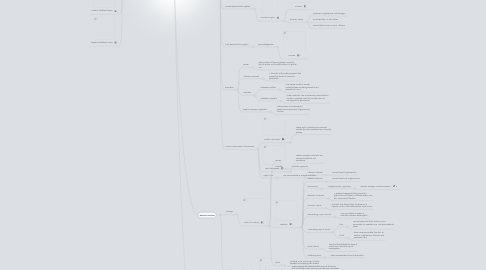
1. General Concepts
1.1. Poikilotherms
1.2. Homeotherms
1.3. Positive feedback loops
1.4. Negative feedback loops
2. Definition: The regulation and control of an organism's internal conditions/environment so that it stays in stability and equilibrium in spite of external changes
3. Endocrine System
3.1. Pituitary Gland
3.1.1. Anterior Pituitary (Master gland that produces many hormones essential to the body)
3.1.1.1. ACTH
3.1.1.1.1. Stimulates the Adrenal Cortex
3.1.1.2. FSH
3.1.1.2.1. Stimulates ovarian follicle development in females and spermatogenesis in males
3.1.1.3. LH
3.1.1.3.1. Stimulates corpus luteum development in females and testosterone development in males
3.1.1.4. TSH/TRH
3.1.1.4.1. Stimulates thyroid to release hromones
3.1.2. Posterior Pituitary (Lesser master gland that secretes some hormones and also acts as a storage sac for these hormones)
3.1.2.1. Oxytocin
3.1.2.1.1. Stimulates various contractions such as lactation in mammary glands
3.1.2.2. ADH (Vasopressin)
3.1.2.2.1. Increases water and ion retention rates in kidney
3.2. Adrenal Glands
3.2.1. Adrenal Cortex (releases long term coping agents)
3.2.1.1. Mineralcorticoids
3.2.1.1.1. e.g. Aldosterone that manages directly sodium absorption and indirectly water reabsorption
3.2.1.1.2. Regulates water and ion balance
3.2.1.2. Glucocorticoids
3.2.1.2.1. Manages immune system and metabolic processes
3.2.1.2.2. e.g. cortisone
3.2.2. Adrenal Medulla (releases short term coping agents
3.2.2.1. Norepinphrine
3.2.2.1.1. Performs similar function as to epinphrine
3.2.2.2. Epinphrine
3.2.2.2.1. Evokes "Fight or Flight" response in the sympathetic nervous system. Heightens breathing, heart rates etc.
3.3. Thyroid Glands
3.3.1. Parathyroid Glands
3.3.1.1. Calcitonin
3.3.1.1.1. Regulates calcium levels in blood
3.3.1.2. PTH
3.3.1.2.1. Regulates calcium levels in blood
3.3.2. Thyroxine (T3)
3.3.2.1. Controls rate of Metabolism
3.3.3. Triiodothyronine (T4)
3.3.3.1. Controls rate of Metabolism
3.4. Pancreas
3.4.1. Islets of Langerhans
3.4.1.1. Alpha Cells
3.4.1.1.1. Glucagon
3.4.1.2. Beta Cells
3.4.1.2.1. Insulin
3.5. Hypothalamus
3.5.1. Detects changes in the body and signals the pituitary glands to release various hormones
3.5.2. GnRH (LnRH)
3.5.2.1. Stimulates release of FSH and LH in anterior pituitary
3.6. Female Reproductive System
3.6.1. Menstrual Cycle
3.6.1.1. Process
3.6.1.2. Corpus Luteum
3.6.1.2.1. Produces Progesterone and Estrogen
3.6.1.2.2. Developed by LH stimulation
3.6.1.2.3. Eventually becomes Corpus Albicans
3.7. Male Reproductive System
3.7.1. Spermatogenesis
3.7.1.1. Process
3.8. Disorders
3.8.1. Goiter
3.8.1.1. Inflammation of thyroid glands caused by lack of Iodine and overstimulation of glands TSH
3.8.2. Addison's Disease
3.8.2.1. A disorder of the adrenal glands that causes low levels of hormone production
3.8.3. Diabetes
3.8.3.1. Diabetes Mellitus
3.8.3.1.1. Low Insulin results in excess carbohydrates not being stored and is passed into urine
3.8.3.2. Diabetes Insipidus
3.8.3.2.1. Water retention rate is extremely reduced which results in constant need for urination due to damage of the glomerulus
3.8.4. Bright's Disease (Nephritis)
3.8.4.1. Inflammation and subsequent destruction/impairment of glomerulus function
3.9. Action Mechanisms of Hormones
3.9.1. Protein Hormones
3.9.1.1. These polar molecules are received outside the cell membrane by a receptor protein
3.9.2. Lipid Hormones
3.9.2.1. These non-polar molecules are received inside the cell membrane
3.9.3. Cyclic AMP
3.9.3.1. Key intermediate in enzyme activation
4. Nervous System
4.1. Central Nervous System
4.1.1. Brain
4.1.1.1. Hosts many of the conscious functions of the body such as thought and memory and autonomic functions such as heart rate and breathing in the medulla oblongata
4.1.2. Spinal Cord
4.1.2.1. Hosts many autonomic functions of the body such as quick reflex arcs and acts as a transmitter/relayer of nerve pulses to the brain
4.2. Peripheral Nervous System
4.3. Nerve Impulses
4.3.1. Saltatory Conduction
4.3.1.1. Myelin Sheaths
4.3.1.1.1. insulates the nerve so that the pulse conducts to the next node of ranvier
4.3.1.2. Nodes of Ranvier
4.3.1.2.1. Spaces myelin sheaths and provides the succesive destinations for the saltatory pulses
4.3.2. Summation
4.3.2.1. The combination of the electrical pulses of many nerves. Occurs when axons overlap
4.3.3. Method of Functionality
4.3.3.1. Resting Potential -70mV
4.3.3.1.1. Potassium ions are inside the nerve while sodium ions are outside. Ion gates are closed
4.3.3.2. Stimulus
4.3.3.2.1. Opens sodium gates to allow Na+ ions to flow into the nerve
4.3.3.3. Threshold Potential -55mV
4.3.3.3.1. The threshold of all or nothing action. If the stimulus does not reach this threshold, there will be no action
4.3.3.4. Depolarization +50mV
4.3.3.4.1. A large surge of sodium ions into the nerve causes the potential to become positive and initiates the electrical pulse. Sodium gates begin to close slowly during this
4.3.3.5. Repolarization
4.3.3.5.1. The potassium ions inside the nerve flow out into the ECF and restores the concentration gradient.
4.3.3.6. Undershoot Potential
4.3.3.6.1. Excessive K+ moves out of the nerve and can overshoot the potential to - 85 mV
4.4. Neuron
4.4.1. Sensory/Motor Neuron
4.4.1.1. Axon
4.4.1.1.1. Conveys electrical pulses down to the dendrites of other neurons
4.4.1.2. Dendrite
4.4.1.2.1. Receives nerve impulses
4.4.1.3. Soma
4.4.1.3.1. Cell body that hosts organelles
4.4.1.4. Myelin Sheaths
4.4.1.4.1. Present in saltatory conduction sites to insulate the axon
4.4.2. Synapses
4.4.2.1. Vesicles
4.4.2.1.1. Holds neurotransmitters in axon end
4.4.2.2. Neurotransmitters
4.4.2.2.1. Various chemicals (ex. acetylcholine) that lock on to the enzymes of the next neuron to continue the nerve signal by initiating another stimulus
4.5. General Systems
4.5.1. Sympathetic nervous system
4.5.1.1. The stress response nervous circuit of the body that prepares the body for stressful situations through the release of hormones such as epinphrine
4.5.2. Parasympathetic nervous system
4.5.2.1. The "brake" to the sympathetic system, this manages many of the functions that restore the body to its original state by undergoing digestion, excretion etc.
5. Exocrine System
5.1. Kidneys
5.1.1. Parts of a Kidney
5.1.1.1. Cortex
5.1.1.2. Medulla
5.1.1.2.1. Medullic Pyramids
5.1.1.3. Nephron
5.1.1.3.1. Afferent Arteriole
5.1.1.3.2. Efferent Arteriole
5.1.1.3.3. Glomerulus
5.1.1.3.4. Bowman's Capsule
5.1.1.3.5. Proximal Tubule
5.1.1.3.6. Descending Loop of Henle
5.1.1.3.7. Ascending Loop of Henle
5.1.1.3.8. Distal Tubule
5.1.1.3.9. Collecting Duct
5.1.1.4. Pelvis
5.1.1.4.1. Collects urine and brings it to the bladder by emptying into ureters
5.2. Bladder
5.2.1. Stores urine for expulsion from body
